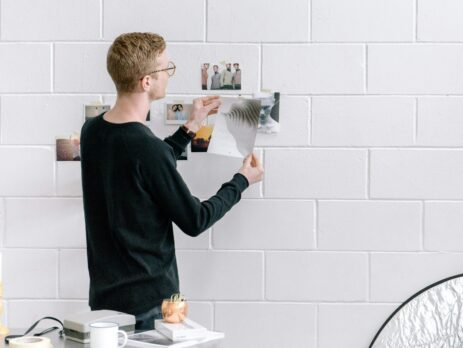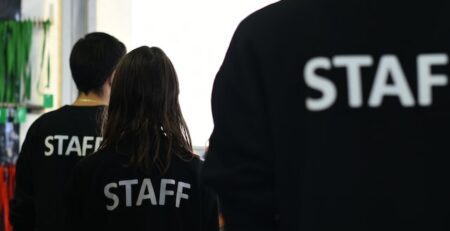The Hiring Blueprint: Strategies for Onboarding Creative Directors
Onboarding a creative director is a critical process for any organization looking to enhance its creative output and brand identity. This role, pivotal in shaping the company’s creative vision, demands a strategic approach to recruitment and integration into the company’s culture. A creative staffing agency can be instrumental in this process, providing expertise and tailored solutions to find the right talent.
The role of a creative director goes beyond just overseeing the creative team. It involves setting the artistic direction, strategizing on brand image, and collaborating across departments to ensure that the creative vision aligns with business goals. Therefore, the onboarding process must be meticulously planned to empower the creative director with the necessary tools and insights about the company’s ethos, goals, and expectations.
Effective onboarding should begin even before the creative director starts their role. Clear communication about the company’s expectations, the scope of their role, and the company culture can set the stage for a smooth transition. Utilizing resources from a creative staffing agency can help in outlining these elements professionally.
Once on board, introducing the creative director to key team members and stakeholders is crucial. This not only helps in building essential relationships but also in understanding the dynamics and workflows of the team. A structured orientation program can facilitate this integration, with presentations and meetings designed to immerse the creative director in every aspect of the company.
Training programs tailored to the specifics of the company can also enhance the onboarding experience. Whether it’s software, company policies, or the creative workflow, ensuring that the creative director is well-versed in these areas will aid in a seamless transition. Engaging them in projects that reflect real challenges and opportunities can also provide practical insights and foster a deeper understanding of the company’s operations and market challenges.
Setting up a mentorship or a buddy system can further aid the onboarding process. Pairing the new creative director with a seasoned executive or another director can help them navigate the company’s cultural and operational landscape more effectively. This relationship can provide them with a go-to person for queries and advice, easing the acclimatization period.
Regular feedback and discussions about progress are essential to ensure the onboarding process is on track. Utilizing tools and insights from performance reviews can help in identifying any areas of concern and celebrating early wins, which is crucial for building confidence and motivation.
The role of technology in onboarding cannot be understated. From streamlined HR systems for onboarding paperwork to digital tools for creative collaboration, technology can enhance the efficiency and effectiveness of the onboarding process. A creative staffing agency might provide access to cutting-edge tools and technologies that can be integrated into the onboarding program.
Finally, understanding that the onboarding process is a journey that might require adjustments and flexibility is key. Each creative director will bring their unique style and perspective, and the onboarding process should allow room for this individuality while aligning it with the company’s objectives and culture.
By investing in a thorough and thoughtful onboarding process, companies can ensure that their new creative directors are well-equipped to take on their roles and drive the creative vision forward. This not only benefits the creative outputs but also contributes to the overall strategic goals of the company, making it a critical investment in the company’s future.
Most Asked Questions About Onboarding Creative Directors
- What are the key components of an effective onboarding program for a creative director?
- How can a creative staffing agency aid in the onboarding process of a creative director?
- What are the common challenges faced during the onboarding of a new creative director and how to overcome them?
- How long should the onboarding process for a creative director last?
- What role does mentorship play in the successful onboarding of a creative director?
- How important is cultural fit when onboarding a new creative director?
- What are the best practices for integrating a creative director into existing teams?
Key Components of an Effective Onboarding Program for a Creative Director
The onboarding of a creative director is a nuanced process that requires attention to several key components to ensure success. These components serve as the building blocks of an effective onboarding program, each contributing to a smooth transition and the long-term success of the creative director within the company.
Pre-boarding Communication: Before the creative director even steps into the office, it’s crucial to set the right expectations. This involves clear communication about the job role, company culture, and what they can expect in their first few days and weeks. Pre-boarding communication helps in reducing first-day anxiety and sets a positive tone.
Formal Orientation: A structured orientation session is essential. This should cover everything from company history and goals to key projects and team structures. It’s also a good opportunity to introduce the creative director to the tools and technologies they will be using.
Introduction to Key Team Members: Building relationships is crucial in any role, but especially for a creative director who will need to collaborate across various teams. Organizing meet-and-greets with key team members and stakeholders can facilitate these important connections.
Training and Development: Tailored training sessions that cover everything from operational procedures to creative processes within the company can be very beneficial. This might include hands-on projects to help the creative director understand the team’s workflow and creative ethos.
Mentorship Programs: Pairing the creative director with a mentor can provide them with guidance and support as they navigate their new role. This mentor could be another director or a senior leader within the company.
Regular Feedback and Adjustments: Setting up regular check-ins to discuss progress and any challenges can help in making necessary adjustments to the onboarding process. This feedback loop is essential for continuous improvement and helps the creative director feel valued and heard.
Cultural Immersion: Understanding and integrating into the company culture is vital for any new hire. Activities that immerse the creative director in the company’s culture can accelerate this process and help in building a stronger connection with the company.
Performance Goals: Early on, it’s important to define clear, achievable goals. This helps the creative director to have a clear direction and understand what success looks like in their new role.
Technology Integration: Utilizing technology not only for the creative processes but also for streamlining the onboarding steps can lead to a more efficient transition. Whether it’s digital onboarding forms or collaborative tools, technology can play a pivotal role.Flexibility and Customization: Finally, recognizing that each creative director is unique and may require a customized approach to their onboarding can make a significant difference. Flexibility to adapt the onboarding process to fit the individual’s needs can lead to better outcomes.

Role of a Creative Staffing Agency in Onboarding a Creative Director
A creative staffing agency plays a pivotal role in the onboarding process of a creative director by bridging the gap between the creative talent and the company’s specific needs. These agencies specialize in understanding the nuances of creative roles, making them an invaluable partner in this critical phase.
Talent Matching: The first step where a creative staffing agency adds value is during the recruitment phase. They ensure that the creative director not only has the required skills but also aligns with the company’s culture and vision. This alignment is crucial for long-term success.
Pre-boarding Processes: Agencies can facilitate the pre-boarding process by providing comprehensive briefs to the candidates about the company, thus ensuring they are well-prepared and properly aligned with the company’s expectations before their first day.
Orientation Assistance: Often, staffing agencies provide support materials or sessions that can be used during the orientation process. These might include detailed guides on company culture, key projects, and internal processes.
Training Modules: Some agencies offer customized training modules that can be integrated into the company’s onboarding program. These modules are tailored to the creative industry and can cover everything from creative leadership to specific design tools.
Mentorship Arrangement: Leveraging their network, staffing agencies can help set up mentorship programs by connecting new hires with industry veterans who can guide them through the initial months.
Feedback Systems: Agencies can also assist in establishing effective feedback mechanisms. They often provide tools and frameworks for performance reviews that are specifically designed for creative roles.
Cultural Integration: Understanding the importance of cultural fit, staffing agencies often provide insights and strategies on how best to integrate the creative director into the company culture effectively.
Ongoing Support: Even after the onboarding process, creative staffing agencies can offer ongoing support and consultation to help the creative director and the company navigate any potential challenges.
Customization of Onboarding: Recognizing the unique needs of each hire, agencies can offer advice on customizing the onboarding process to better suit the individual’s style and the company’s requirements.
Technology Recommendations: Finally, with their finger on the pulse of the latest industry technologies, creative staffing agencies can recommend tools and software that can enhance the onboarding experience and the creative director’s productivity.
Common Challenges in Onboarding Creative Directors and Solutions
The onboarding of a creative director can come with its set of challenges, each potentially impacting the smooth transition and integration of the new hire into the company. Recognizing these challenges early and preparing strategies to overcome them can significantly enhance the effectiveness of the onboarding process.
Cultural Misalignment: One of the most significant challenges is ensuring that the creative director aligns well with the company culture. Misalignment can lead to friction and reduced effectiveness. To mitigate this, companies can invest in thorough cultural orientation sessions and regular culture-fit assessments.
Resistance from Existing Teams: Sometimes, existing teams may be resistant to new leadership, especially if it involves significant changes in processes or creative direction. Building early relationships through team-building activities and open communication channels can help in easing this transition.
Overwhelming Information Load: The initial days can be overwhelming for a new creative director with a flood of new information. To manage this, companies should consider a phased approach to information sharing, prioritizing the most critical information first.
Unclear Role Expectations: Unclear expectations can lead to confusion and underperformance. Clear, documented communication about role expectations and success metrics from the start can prevent this issue.
Lack of Proper Resources: Not having the right tools or resources can hinder the creative director’s ability to perform effectively. Ensuring that all necessary tools and resources are available from day one is crucial.
Inadequate Feedback Mechanisms: Without proper feedback, it can be challenging for the creative director to adjust and improve. Establishing a robust feedback system, possibly with the help of a creative staffing agency, can facilitate continuous improvement.
Navigating Internal Politics: Internal politics can often pose a challenge for any new hire. Providing a mentor who can offer insights and guidance on the internal dynamics can help the creative director navigate this landscape more effectively.
Adjustment to Leadership Style: Every creative director has their unique leadership style, which may or may not immediately gel with the team’s working style. Encouraging open dialogues about leadership and working styles can help in finding a middle ground.
Technology Adaptation: Adapting to new technologies or systems can be a hurdle. Providing comprehensive training and access to tech support can ease this transition.
Personal Adjustment: Moving to a new company can also be personally challenging. Support in terms of relocation assistance, if applicable, and ensuring a work-life balance can help the creative director settle in more comfortably.
Optimal Duration for Onboarding a Creative Director
The duration of the onboarding process for a creative director can vary significantly depending on the complexity of the role and the company’s structure. However, a well-planned onboarding timeline is crucial for ensuring the director is fully integrated and ready to contribute effectively.
First Week: The initial week should focus on introductions and orientations. This is the time for the creative director to learn about the company’s mission, vision, and operational workflows. It’s also a good period for them to start forming key relationships within the company.
First Month: By the end of the first month, the creative director should have a good understanding of their role and responsibilities. This phase should include deeper dives into ongoing projects and more hands-on involvement in creative processes.
First Three Months: The first quarter is critical for setting short-term goals and starting to influence the creative direction. The creative director should be more involved in strategic planning and execution, with regular feedback sessions to gauge their integration and effectiveness.
Six Months to One Year: This period should see the creative director fully integrated into the company, with clear contributions to projects and visible leadership within the team. Ongoing training and development should continue to adapt to any evolving company needs or personal growth goals.
Beyond One Year: After the first year, the onboarding process is typically considered complete, but continuous professional development and adjustment to evolving roles or goals should be maintained. This ensures the creative director remains engaged and productive.
It’s important to note that flexibility in the onboarding timeline is crucial. Each creative director will bring their unique experiences and skills to the role, which might accelerate or extend certain phases of the onboarding process.
Mentorship’s Role in Onboarding Creative Directors
Mentorship can play a transformative role in the onboarding of a creative director, providing them with guidance, insights, and support as they navigate their new role. The benefits of incorporating a mentorship program into the onboarding process are manifold.
Accelerated Learning Curve: A mentor can help shorten the learning curve by sharing insights and experiences that are specific to the company or the industry. This can be particularly valuable in creative roles where understanding the company’s creative vision and processes is crucial.
Enhanced Network Building: Mentors can introduce the new creative director to key figures within and outside the company, helping them to build a network that can support their work and career growth.
Increased Confidence: Having a trusted advisor can boost the new director’s confidence, which is essential when taking on a leadership role in a new environment.
Support During Challenges: A mentor can provide support and practical advice during challenging times, helping the creative director to navigate complex situations more effectively.
Feedback and Perspective: Regular feedback from a mentor can help the creative director understand how they are perceived within the company and where they can improve.
Cultural Integration: A mentor who is well-versed in the company’s culture can help the creative director understand and integrate into the culture more quickly and deeply.
Leadership Development: Mentors can also play a crucial role in developing the leadership skills of the creative director, preparing them for future challenges and opportunities.
Problem Solving: By discussing various scenarios and problems, a mentor can help the creative director enhance their problem-solving skills, which are crucial in a creative leadership role.
Strategic Insight: Mentors often provide strategic insights that can help the creative director make more informed decisions that align with the company’s long-term goals.
Personal Growth: Beyond professional development, mentors can also influence personal growth by encouraging a balance between work and personal life, which is essential for creative roles.

Importance of Cultural Fit in Onboarding Creative Directors
The cultural fit of a creative director within an organization is a critical factor that can significantly impact their success and longevity in the role. A creative director who aligns well with the company culture is more likely to foster a positive work environment and drive creative initiatives that resonate with the company’s goals.
Understanding Company Values: It’s crucial for the creative director to understand and embrace the company’s core values. These values are often reflected in the company’s creative output, and misalignment can lead to conflicts and misunderstandings.
Enhancing Team Dynamics: A creative director who is a good cultural fit can enhance team dynamics, fostering a collaborative and innovative work environment. This is particularly important in creative settings where teamwork can significantly influence the quality and effectiveness of the creative output.
Long-term Engagement: Cultural fit also affects the long-term engagement and retention of a creative director. When they feel aligned with the company’s culture, they are more likely to remain committed and motivated in their role.
Effective Leadership: Effective leadership in creative roles requires an understanding of the cultural nuances of the company. A creative director who fits well with the culture will be more effective in leading the team and driving the creative vision.
Reduced Friction: A good cultural fit reduces friction and resistance, both from the creative director and the team they lead. This smooth integration can lead to more efficient and effective creative processes.
Better Decision Making: When a creative director understands the cultural context of the company, their decisions are more likely to align with the company’s goals and values, leading to better outcomes.
Enhanced Communication: Cultural fit also enhances communication, making it more effective and efficient. This is crucial in creative roles where clear and precise communication can significantly impact project outcomes.
Increased Innovation: A creative director who aligns well with the company culture is more likely to feel secure and supported, fostering an environment where innovation can thrive.
Alignment with Client Expectations: Often, the company culture is part of the brand identity, which clients recognize and expect. A creative director who understands and embodies this culture can better meet client expectations.
Employee Satisfaction: Lastly, a creative director who is a good cultural fit is generally more satisfied with their job, which can lead to higher productivity and a more positive workplace atmosphere. This satisfaction often translates into higher quality creative work, which is essential for the success of any creative enterprise.
Best Practices for Integrating a Creative Director into Existing Teams
Integrating a creative director into existing teams is a delicate process that requires careful planning and execution. Here are some best practices to ensure a smooth integration:
Clear Communication: Establish clear lines of communication from the start. Ensure that the creative director understands their role and the roles of those they will be working with. This clarity can prevent misunderstandings and set the stage for effective collaboration.
Set Integration Goals: Define specific, measurable goals for the integration process. These goals can help track progress and ensure that the integration is moving in the right direction.
Foster Team Building: Organize team-building activities that can help the creative director and the team members get to know each other on a more personal level. This can build trust and improve teamwork.
Encourage Open Dialogue: Create an environment where open dialogue is encouraged. Allow team members to express their thoughts and concerns about the new integration, and ensure the creative director is receptive to this feedback.
Provide Support: Both the creative director and the team may need support during the integration process. This could be in the form of additional training, resources, or even mediation to address any conflicts that arise.
Celebrate Early Wins: Recognize and celebrate early successes in projects where the creative director and the team collaborate effectively. This can boost morale and encourage further collaboration.
Monitor and Adjust: Regularly monitor the integration process and be prepared to make adjustments as needed. This could involve changing workflows, communication strategies, or even team compositions to better suit the new dynamics.
Lead by Example: Encourage senior management to support the integration process actively. Their involvement can set a positive example and emphasize the importance of the integration to the rest of the company.
Respect Existing Processes: While it’s important for the creative director to bring in new ideas, they should also respect the existing processes and traditions of the teams. This respect can help them gain trust and cooperation from team members.
Continuous Learning: Encourage a culture of continuous learning where both the creative director and the team members can learn from each other. This can lead to ongoing improvement and innovation.
Conclusion: Ensuring a Successful Onboarding and Integration of Creative Directors
The onboarding and integration of a creative director are crucial processes that can significantly impact the creative output and overall success of an organization. By focusing on effective onboarding strategies, such as clear communication, tailored training, and cultural integration, companies can ensure that their new creative directors are well-equipped to lead their teams to new heights of creativity and innovation.
Furthermore, the role of a creative staffing agency in this process is invaluable. These agencies not only help in finding the right talent but also support the onboarding and integration process with their expertise and resources. This support can make a significant difference in how quickly and effectively a creative director can become a productive member of the team.
Challenges in onboarding and integration, such as cultural misalignment or resistance from existing teams, can be mitigated through planned strategies and best practices. Regular feedback, mentorship, and ongoing support are essential components that help in adjusting the onboarding process to better suit the needs of the creative director and the organization.
The duration of the onboarding process can vary, but it should be comprehensive enough to cover all critical aspects of the role and the company. A phased approach, starting with basic orientation and gradually moving to deeper involvement, can be particularly effective.
Mentorship plays a critical role in this process, providing guidance, support, and insights that are crucial for the successful integration of a creative director. This support system not only helps in professional development but also in personal adjustment to the new role and environment.
Finally, ensuring a good cultural fit and effectively integrating the creative director into existing teams are pivotal. These elements not only affect the creative director’s ability to perform but also impact the overall morale and productivity of the team. By adhering to best practices and fostering an environment of collaboration and respect, companies can maximize the potential of their creative leadership and steer their creative endeavors towards success.
In conclusion, the strategic onboarding and integration of a creative director are not just about filling a role but about setting up a leader and a team for long-term success. With the right approach, tools, and support, this process can lead to transformative outcomes for both the creative director and the organization.
In today’s competitive market, finding the right creative and marketing expert can be a challenge. But with icreatives, you’re in experienced hands. With 37 years in staffing and a track record of matching more than 10,000 employees to over 1,000 companies worldwide, we know how to connect you with the best. Plus, you only pay if you hire—there’s no risk, only results.
Ready to find your perfect creative or marketing expert? HIRE WITH ICREATIVES today!












